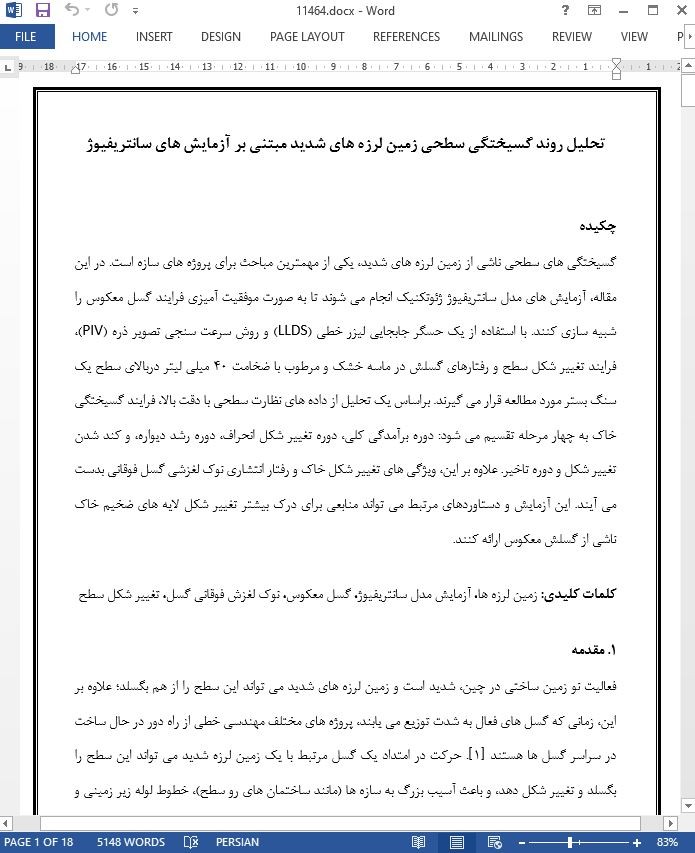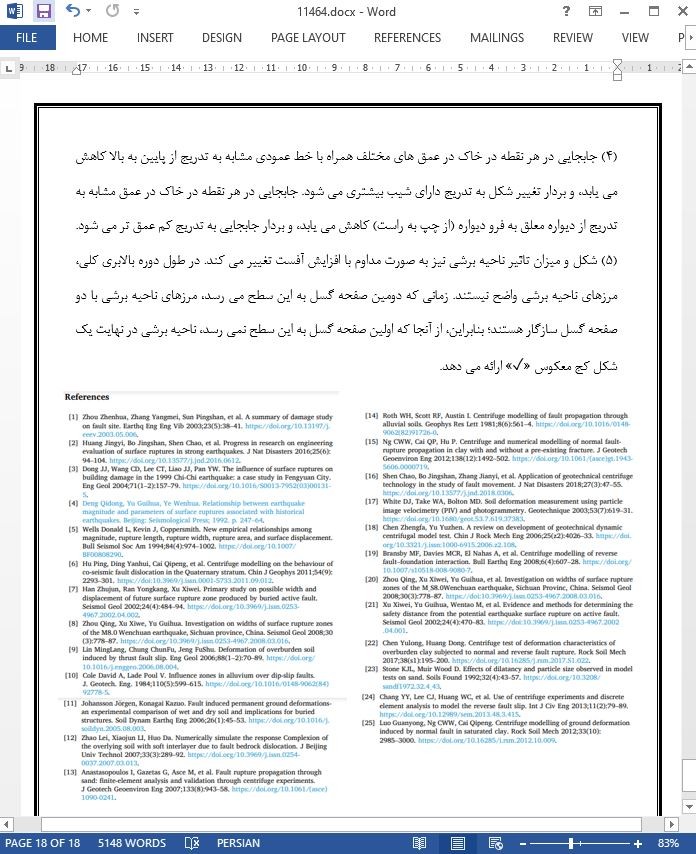
تحلیل روند گسیختگی سطحی زمین لرزه های شدید مبتنی بر آزمایش های سانتریفیوژ
چکیده
گسیختگی های سطحی ناشی از زمین لرزه های شدید، یکی از مهمترین مباحث برای پروژه های سازه است. در این مقاله، آزمایش های مدل سانتریفیوژ ژئوتکنیک انجام می شوند تا به صورت موفقیت آمیزی فرایند گسل معکوس را شبیه سازی کنند. با استفاده از یک حسگر جابجایی لیزر خطی (LLDS) و روش سرعت سنجی تصویر ذره (PIV)، فرایند تغییر شکل سطح و رفتارهای گسلش در ماسه خشک و مرطوب با ضخامت 40 میلی لیتر دربالای سطح یک سنگ بستر مورد مطالعه قرار می گیرند. براساس یک تحلیل از داده های نظارت سطحی با دقت بالا، فرایند گسیختگی خاک به چهار مرحله تقسیم می شود: دوره برآمدگی کلی، دوره تغییر شکل انحراف، دوره رشد دیواره، و کند شدن تغییر شکل و دوره تاخیر. علاوه بر این، ویژگی های تغییر شکل خاک و رفتار انتشاری نوک لغزشی گسل فوقانی بدست می آیند. این آزمایش و دستاوردهای مرتبط می تواند منابعی برای درک بیشتر تغییر شکل لایه های ضخیم خاک ناشی از گسلش معکوس ارائه کنند.
1. مقدمه
فعالیت نو زمین ساختی در چین، شدید است و زمین لرزه های شدید می تواند این سطح را از هم بگسلد؛ علاوه بر این، زمانی که گسل های فعال به شدت توزیع می یابند، پروژه های مختلف مهندسی خطی از راه دور در حال ساخت در سراسر گسل ها هستند [1]. حرکت در امتداد یک گسل مرتبط با یک زمین لرزه شدید می تواند این سطح را بگسلد و تغییر شکل دهد، و باعث آسیب بزرگ به سازه ها (مانند ساختمان های رو سطح)، خطوط لوله زیر زمینی و تونل ها شود و تهدید جدی برای اموال و زندگی افراد باشد [2]. بعنوان مثال، زمین لرزه چی-چی به بزرگی 7.6 ریشتر در سال 1999 و زمین لرزه ونچوآن به بزرگی 8.0 ریشتر در سال 2008 باعث ایجاد گسیختگی های وسیع سطح شدند، و پِی های زیاد سد، پل های جاده ای و خطوط لوله زیرزمینی آسیب دیدند [3].
6. نتیجه گیری
در این مقاله، تغییر شکل خاک در 40 متری یک گسل معکوس توسط یک آزمون مدل سانتریفیوژ در 100 g شبیه سازی می شود، و مشخصات تغییر شکل ماسه خشک و مرطوب از یک گسل بستر سنگ با یک زاویه شیب 60 درجه بدست می آید. این نتایج می توانند منابعی را برای درک بیشتر مکانیسم خرابی خاک پوشیده شده یک گسل معکوس پنهان ارائه کنند. نتایج تحقیقاتی اصلی زیر ترسیم می شوند.
(1) در ابتدا، این سطح یک مرحله کلی بالابری است، و یک اسکارپ (پرتگاه) به ندرت قابل مشاهده است. در این لحظه، خاک شامل سه ناحیه مشخص است: ناحیه بالابری دیواره معلق، ناحیه ساکن فرو دیواره و ناحیه برشی میانی. این سطح زمانی شروع به تغییر شکل می کند که میزان آفست تحمیلی تقریبا 2.2% ضخامت خاک در نظر گرفته می شود.
Abstract
Surface ruptures caused by strong earthquakes are one of the most concerning issues for construction projects. In this paper, geotechnical centrifuge model tests is performed to successfully simulate the reverse faulting process. Using a linear laser displacement sensor (LLDS) and the particle image velocimetry (PIV) technique, the surface deformation process and faulting behaviours are studied in dry and wet sand with a thickness of 40 m above a bedrock surface. Based on an analysis of high-precision surface monitoring data, the soil rupture process is divided into four stages: the overall uplift period, inclination deformation period, scarp growth period, and deformation slowdown and lag period. In addition, the characteristics of the soil deformation and the propagation behaviour of the upper fault tip are obtained. This experiment and related achievements can provide references for further understanding the deformation of thick soil layers caused by reverse faulting.
1. Introduction
The neotectonic activity in China is strong, and strong earthquakes can rupture the surface; moreover, as active faults are widely distributed, various long-distance linear engineering projects are being constructed across faults [1]. Movement along a fault associated with a strong earthquake can rupture and deform the surface, causing great damage to structures (such as buildings on the surface), underground pipelines and tunnels and seriously threatening people’s lives and property [2]. As examples, the magnitude 7.6 Chi-Chi earthquake in 1999 and the magnitude 8.0 Wenchuan earthquake in 2008 caused large-scale surface ruptures, and numerous dam foundations, road bridges and underground pipelines were damaged [3].
6. Conclusion
In this paper, the deformation of soil within 40 m of a reverse fault is simulated by a centrifuge model test at 100g, and the deformation characteristics of dry and wet sand resulting from a bedrock fault with a dip angle of 60 are obtained. The results can provide references for further understanding the failure mechanism of soil overlying a concealed reverse fault. The following main research conclusions are drawn.
(1) At the beginning, the surface is in an overall uplift stage, and a scarcely obvious scarp is observed. At this moment, the soil comprises three distinct zones: the hanging wall uplift zone, foot wall quiescent zone and intermediate shear zone. The surface begins to deform when the amount of imposed offset accounts for approximately 2.2% of the thickness of the soil.
چکیده
1. مقدمه
2. تجهیزات و روش آزمایش
2.1. مقدمه ای بر سانتریفیوژ و چیدمان ابزار
2.2. روش آزمایش سانتریفیوژ
3. طراحی مدل و آماده سازی خاک
4. تکامل تغییر شکل و خرابی لایه سنگین بار ناشی از گسلش
4.1. استقرار سیستم مختصات مدل خاک
4.2. تکمیل تغییر شکل و خرابی خاک
5. تحلیل خصوصیات تغییر شکل خاک و گسلش
5.1. خصوصیات تغییر شکل سطح
5.2. مشخصات انتشاری نوک لغزش فوقانی صفحه گسل
5.3. خصوصیات تغییر ناحیه برشی
6. نتیجه گیری
ABSTRACT
1. Introduction
2. Test equipment and method
2.1. Introduction to the centrifuge and instrument layout
2.2. Centrifuge test procedure
3. Model design and soil preparation
4. Evolution of the deformation and failure of the overburden layer caused by faulting
4.1. Establishment of the soil model coordinate system
4.2. Evolution of soil deformation and failure
5. Analysis of the characteristics of soil deformation and faulting
5.1. Surface deformation characteristics
5.2. Propagation characteristics of the upper tip of the fault plane
5.3. Shear zone variation characteristics
6. Conclusion
- ترجمه فارسی مقاله با فرمت ورد (word) با قابلیت ویرایش، بدون آرم سایت ای ترجمه
- ترجمه فارسی مقاله با فرمت pdf، بدون آرم سایت ای ترجمه



